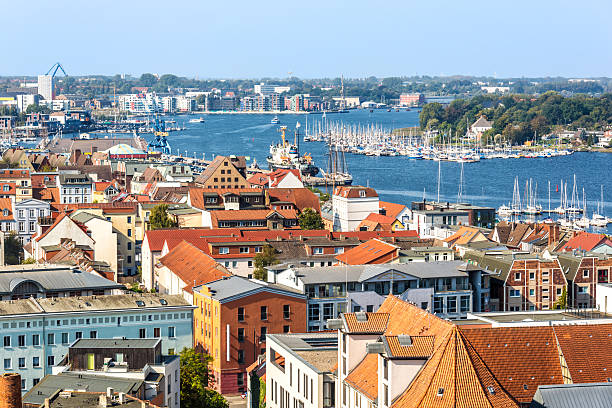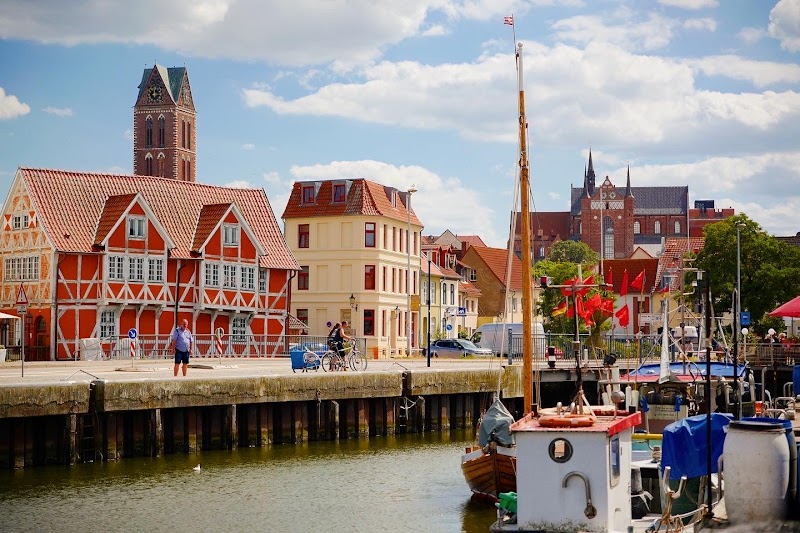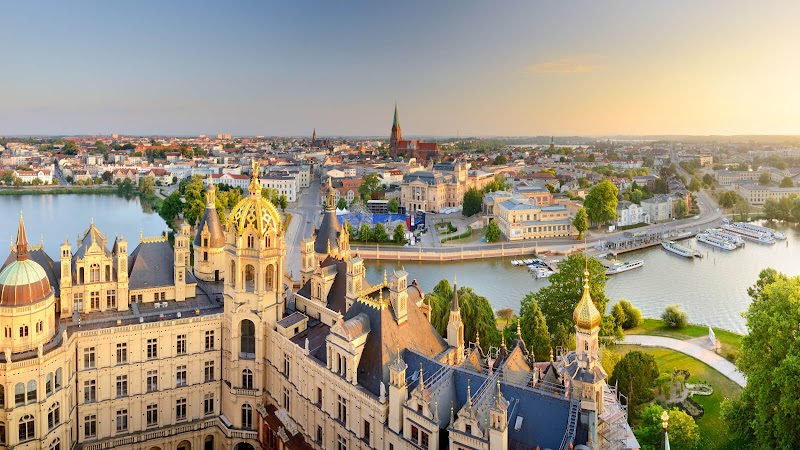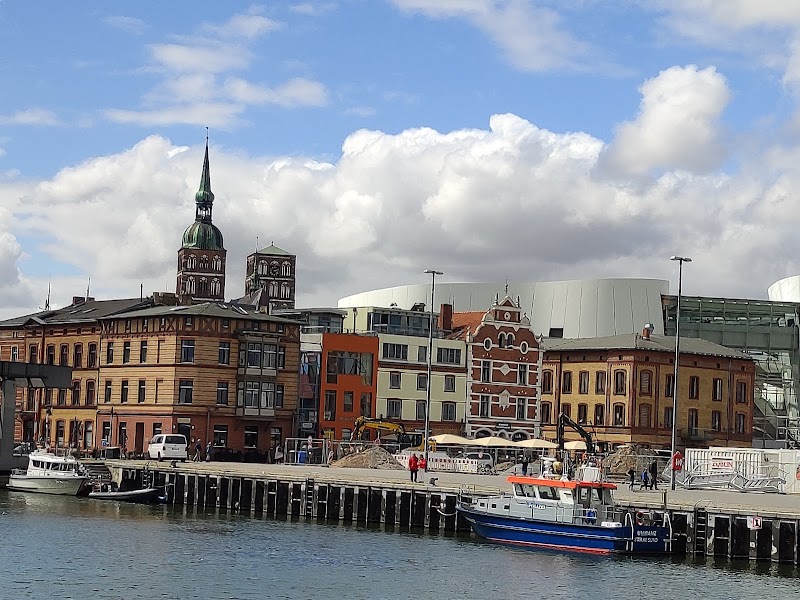Welcome to Mecklenburg-Western Pomerania
Did you know that Mecklenburg-Western Pomerania is a treasure trove of over 2,000 palaces, parks, and gardens? This fairy-tale land is a perfect mix of natural beauty and historic grandeur, from the jaw-dropping chalk cliffs of Rügen Island to the grandiosity of Schwerin Castle and the serene Lake Müritz. Every nook and cranny of Mecklenburg-Western Pomerania is filled with stories from the past, beckoning you to explore its secrets.
As you map out your adventure, the Tourist Map of Mecklenburg-Western Pomerania will become your best friend. It's more than just a map; it's a key to the region's treasures, helping you weave your own unique travel narrative. It will guide you through the region's diverse landscapes, showing you hidden gems that will make your trip unforgettable. With it, you'll find your way to experiences that resonate with your travel desires creating memories to treasure forever.
" Booking.comImmerse Yourself in the Richness of Mecklenburg-Western Pomerania
When it comes to diving into the rich tapestry of Germany's history and culture, few places can compare to Mecklenburg-Western Pomerania, the perfect blend of adorable coastal towns, lush green forests, and historic architecture. This region offers a unique blend of attractions sure to captivate any traveler. Here are some must-see spots in Mecklenburg-Western Pomerania:
- Doberan Minster
- Rostock's St. Mary's Church
- The Hanseatic City of Wismar
- Stralsund's Maritime Museum
- The island of Usedom
- Peenemünde Historical Technical Museum
Step Back in Time at Doberan Minster
Your journey begins at the Doberan Minster, a magnificent representation of North German Brick Gothic architecture. This former Cistercian abbey exudes tranquility, allowing visitors to delve into the spiritual heritage of the region. Its meticulously preserved interior is an art gallery of medieval art and craftsmanship, making it a must-visit for any history enthusiast.
Experience the Grandeur of Rostock's St. Mary's Church
Your next stop is Rostock, where the towering St. Mary's Church awaits. This grand church shelters an astronomical clock built in 1472, a testament to the engineering marvels of the middle ages that still functions today. In the heart of Rostock's old town, you can also explore quaint stores and cafes for a perfect blend of the past and the present. Don't forget to check out the tourist map of Rhineland for more hidden gems in this charming city.
Uncover the Hanseatic Charm of Wismar
A little further along the coast, the Hanseatic City of Wismar calls out with its stunning collection of preserved medieval architecture, a reflection of its prosperous past as a major trading hub. Wander along the cobblestone streets of the old town, marveling at the grandeur of the Market Square, surrounded by stunning gabled houses. Don't miss the Wasserkunst, an ornate water fountain and one of Wismar's most iconic landmarks.
Discover Maritime History at Stralsund's Maritime Museum
Continue your journey to Stralsund, where the Maritime Museum offers a glimpse into the region's seafaring heritage. Located in a former Dominican monastery, the museum showcases a variety of exhibits, underlining the importance of maritime trade and shipbuilding in the region's history. While in Stralsund, also take the opportunity to visit the breathtaking St. Nicholas' Church, the city's oldest.
Bask in Nature on the Island of Usedom
Finally, round off your journey by embracing the serene natural beauty of Usedom. This sunshine-filled island, known as the "bathtub of Berlin", is home to some of Germany's most beautiful sandy beaches. But there's more than just sunbathing; the island is crisscrossed with trails perfect for hiking and cycling. And for history enthusiasts, the Peenemünde Historical Technical Museum provides an insightful look into WWII rocket technology development.
From the tranquility of monastic life to the vibrant Hanseatic trade, the majesty of Gothic architecture to the serenity of sun-drenched beaches, Mecklenburg-Western Pomerania offers a diverse and enriching experience for every traveler.

Practical Information for Your Mecklenburg-Western Pomerania Visit
Transportation and Mobility
Getting around Mecklenburg-Western Pomerania is a breeze, thanks to its efficient and reliable transportation network. The region is well-connected by air, rail, and road. Rostock-Laage, the region's main airport, offers several domestic and international flights. Meanwhile, the Deutsche Bahn railway network provides convenient connections between major towns and cities like Rostock, Schwerin, and Stralsund. For those who prefer driving, well-maintained highways and scenic country roads offer an enjoyable experience.
You can also explore the region's comprehensive cycling network. The Baltic Sea Cycle Route, one of the longest unbroken bike paths in Europe, is a unique way to take in the region’s stunning coastal vistas. Bike rentals are readily available in most towns and cities.
Schedules and Prices
Popular attractions such as Schwerin Castle, the Doberan Minster, and the Peenemünde Historical Technical Museum typically operate from 10 am to 6 pm. However, arriving early in the morning or later in the afternoon can help you avoid crowds and enjoy a more relaxed visit.
Entry fees for major attractions range from €10 to €20. Discounts are often available for students, seniors, and families. If you're planning to visit multiple attractions, consider investing in a Mecklenburg-Vorpommern card. This card offers free or discounted entry to over 80 attractions and costs €45 for adults and €25 for children.
Safety Tips
Mecklenburg-Western Pomerania is generally safe for tourists. However, common-sense precautions like securing your belongings and being vigilant in crowded places are always advised. If you're cycling, remember to wear a helmet and obey local biking regulations.
Practical Recommendations
The best time to visit Mecklenburg-Western Pomerania depends on your interests. Beach lovers will enjoy the warm temperatures and sunny weather of the summer months, from June to August. If water sports are your thing, spring and autumn are ideal for sailing and windsurfing due to the perfect wind conditions.
Lastly, always check the local weather forecast before planning outdoor activities, especially boat trips or bike tours. Sudden changes in weather, particularly along the Baltic Sea coast, can happen.

Frequently Asked Questions
When planning your trip to Mecklenburg-Western Pomerania, you might have some specific questions. We provide answers below to make your travel planning even smoother.
1. What local delicacies can I try in Mecklenburg-Western Pomerania?
Seafood lovers will be in paradise in Mecklenburg-Western Pomerania, especially known for its fresh Baltic herring, smoked eel, and flounder. For those with a sweet tooth, traditional Sanddorn (sea buckthorn) products like jams, liquors, and sweets are a must-try. The region is also famous for its robust and hearty dishes like Sauerbraten (a pot roast) and Bratwurst.
2. Can I bring my pet to Mecklenburg-Western Pomerania?
Yes, you certainly can! Many hotels, guesthouses, and holiday homes in Mecklenburg-Western Pomerania are pet-friendly. However, it's best to check with your accommodation provider beforehand. Note that certain beaches might have restrictions during the summer months, so checking local regulations is important.
3. What are the shopping opportunities in Mecklenburg-Western Pomerania?
From quaint boutiques and local markets to large shopping malls, Mecklenburg-Western Pomerania offers a diverse shopping experience. Rostock and Schwerin are popular for their pedestrian zones filled with a variety of stores. Don't forget to look for local crafts and delicacies as souvenirs!
4. Are there opportunities for bird watching in Mecklenburg-Western Pomerania?
Indeed, there are! With its numerous national parks and nature reserves, Mecklenburg-Western Pomerania is a bird watcher's paradise. The Müritz National Park and the Western Pomerania Lagoon Area National Park are particularly famous for their diverse bird species.
5. Are there any unique cultural traditions in Mecklenburg-Western Pomerania?
Yes, the region is known for its traditional folk festivals like the Slavic Störtebeker Festspiele and the Nordic Hanse Sail. The latter is one of the world's largest gatherings of traditional sailing ships and attracts hundreds of thousands of visitors every year.
6. Is it possible to rent a boat or a yacht in Mecklenburg-Western Pomerania?
Yes, with its extensive network of lakes and canals, Mecklenburg-Western Pomerania is perfect for boating holidays. You can find numerous boat and yacht rental services in the region, particularly around Lake Müritz and the Baltic Sea coast.


